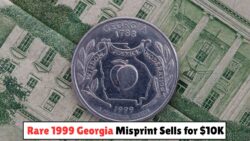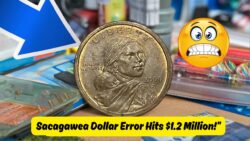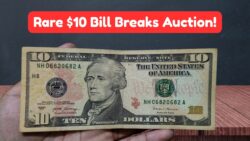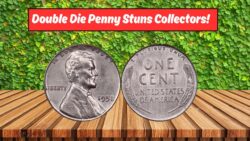1996 $20 Bill – Most people look at their paper currency and think it’s worth exactly what’s printed on it — $20 is $20, right? Not always. A rare printing error or security flaw on a bill can transform it into a collector’s dream worth thousands of dollars. One such example is a rare 1996 $20 Federal Reserve Note that contains a security flaw so unique it has fetched over $45,000 at auction. This surprising valuation has sent many people scrambling to inspect their old wallets, shoeboxes, and even kitchen drawers. Here’s everything you need to know about this valuable error note, what makes it so rare, and how you can determine if you’re holding onto a small fortune.
What Makes the 1996 $20 Bill So Special?
Before jumping to grab every old bill in your possession, it’s important to understand what exactly makes this particular note rare and valuable.
- Date and Series: The note must be from the 1996 series of the $20 Federal Reserve Note.
- Security Flaw: A major printing error or flaw occurred in some batches — such as misaligned security threads, color-shifting ink not functioning properly, or ghost images from misprints.
- Collector Appeal: Currency collectors and error note enthusiasts consider these types of bills highly desirable.
- Condition Matters: Notes in crisp, uncirculated condition fetch the highest prices.
Types of Rare Errors Found on the 1996 $20 Bill
Some of the most common and valuable printing flaws seen on this particular bill include:
Notable Printing Errors That Add Value
 This 1999 Georgia Quarter With Misprint Just Hit $10,000 at Auction – Still in Circulation!
This 1999 Georgia Quarter With Misprint Just Hit $10,000 at Auction – Still in Circulation!
Only specific kinds of errors qualify the note for high collector value.
Misaligned Security Thread
- In many 1996 $20 bills, the security thread was printed too far left or completely outside its normal placement.
- This error makes the bill stand out as non-standard.
Color-Shifting Ink Issues
- The 1996 $20 note was one of the first to use color-shifting ink on the number “20” on the bottom right.
- On some flawed bills, this ink does not change color when tilted — a major security defect.
Missing or Doubled Watermark
- Bills missing the watermark of Andrew Jackson or showing a double image are extremely rare.
- These flaws indicate a failure in the embedding process, making them very collectible.
Ghost Printing or Over-Inking
- Some error notes display duplicated images or ink smudges, known as ghosting or over-inking.
- These are often visible to the naked eye and can drive up the bill’s value.
Real Examples and Auction Values
Collectors and dealers have paid eye-popping amounts for rare versions of this bill.
| Bill Description | Error Type | Condition | Auction Price |
|---|---|---|---|
| 1996 $20 With Misaligned Thread | Security Thread Error | UNC | $45,500 |
| 1996 $20 With No Watermark | Missing Watermark | Fine | $31,000 |
| 1996 $20 With Color Ink Flaw | Color-Shift Failure | Very Fine | $28,900 |
| 1996 $20 With Ghost Print | Ink Ghosting | Almost UNC | $24,000 |
| 1996 $20 Doubled Jackson Image | Overprint Error | UNC | $38,000 |
| 1996 $20 With Misaligned Seals | Alignment Error | Fine | $19,000 |
| 1996 $20 With Ink Smudge | Smear During Print | Good | $8,000 |
Where and How to Check Your 1996 $20 Bills
If you have an old stash of cash, it’s time to take a closer look.
Steps to Identify a Rare 1996 $20 Error Note
- Check the Series: Ensure the bill says “Series 1996” under the Secretary of the Treasury’s signature.
- Examine the Security Thread: Hold it up to the light and check for misalignment.
- Test the Color-Shifting Ink: Tilt the “20” in the bottom right — it should change color from green to black.
- Look for Watermarks: Hold it to the light and verify Andrew Jackson’s watermark is correctly placed.
- Spot Any Ghosting or Doubling: Any extra images or print smears are potential value boosters.
What If You Have One?
Owning a rare 1996 $20 bill doesn’t automatically mean it’s worth thousands. Here’s what to do if you believe you have one:
Get It Authenticated
- Contact reputable currency dealers or grading services like PCGS Currency or PMG (Paper Money Guaranty).
- Have the note graded and authenticated for its error type.
Selling Your Rare Bill
Once authenticated, you can sell it through various platforms:
- Auction houses like Heritage Auctions or Stack’s Bowers
- eBay (for less rare errors)
- Currency collector forums or groups
Make sure to get multiple valuations before selling.
How Many of These Notes Are Out There?
The U.S. Bureau of Engraving and Printing never officially confirmed how many error $20 bills were released in 1996, but collectors estimate only a few hundred of each type may exist. Many likely went unnoticed and were spent in regular transactions — meaning they could still be in circulation, hidden in old books, drawers, or family safes.
Why the Interest in Error Notes Is Growing
With the rise of TikTok and YouTube videos showcasing “coins and bills worth thousands,” public curiosity in rare currency has exploded. Even casual collectors are now searching their pockets for potentially valuable finds.
- Social media virality has created increased demand.
- Error notes are seen as both collectibles and investments.
- Scarcity is driving up value year after year.
If you have a 1996 $20 bill lying around, don’t dismiss it as just another piece of old currency. With the right printing error or security flaw, it could be worth over $45,000. Carefully inspect the note using a magnifying glass and light source. If it shows signs of the rare defects mentioned above, it’s worth getting it authenticated — you might be sitting on a hidden treasure without even knowing it!
FAQs
Q1. How can I tell if my 1996 $20 bill has a rare error?
Check for misaligned threads, missing or doubled watermarks, color ink flaws, and ghost printing under bright light.
Q2. Where can I get my bill authenticated?
Trusted agencies include PCGS Currency and PMG, which provide official grading and certification services.
Q3. Can I sell a rare $20 bill online?
Yes, platforms like eBay or auction sites such as Heritage Auctions are ideal for selling authenticated notes.
Q4. Does the bill’s condition affect its value?
Absolutely. Uncirculated or crisp notes fetch much higher prices than those that are worn or damaged.
Q5. Are there other valuable $20 bill years besides 1996?
Yes, other years like 1990 and 2004 also have known printing errors, but the 1996 bills are currently in high demand.





